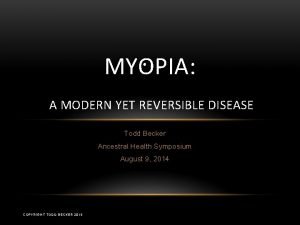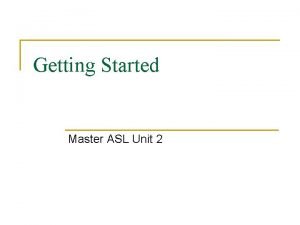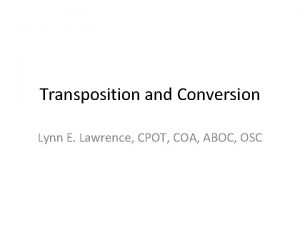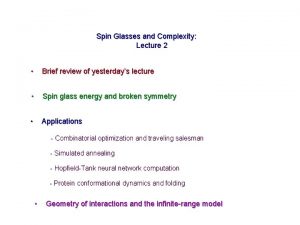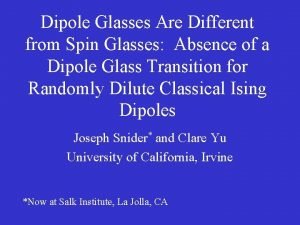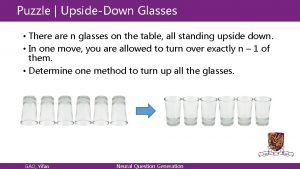My reading glasses dont help a case of














- Slides: 14

“My reading glasses don’t help…” - a case of convergence insufficiency in Parkinson’s Disease OMC Alumni Presentation 20/3/17 DR DAMIEN LING (HMO) DR LIONEL KOWAL

Case Overview Mrs A, 75 F PMHx • Parkinson’s Disease (dx 2006) • Thyroidectomy for MNG (2006) • Complicated by bilat recurrent laryngeal nerve palsies, required tracheostomy and laser arytenoidectomy • Left vocal cord recovered; right remains paralysed • Factor V Leiden • DVTs: R) 2005, L) 2011, R) 2013 • On life-long warfarin • • • T 2 DM (diet) HTN, Chol Hysterectomy (2001) Bilat hip OA Scoliosis

Case Overview Medications • • • Rasagiline 1 mg mane Madopar (levodopa/benserazide) 100 mg/25 mg x 5/day Pramipexole 1. 5 mg nocte Thyroxine 100 mcg mane Warfarin Vitamin D SHx • Lives in nursing home • Retired nurse

Ocular Issues 1. Long-standing XT • Present as a teenager, worse in last 4 -5 years 2. Intermittent diplopia • Was rarely, now >50% of the time • Worse when tired, and when Parkinson’s medications wear off 3. Reading difficulty • Needs to close one eye or shake head 4. Poor depth perception

Examination • VA R 6/12(gls) L 6/9 (gls) • Near: R N 5 L N 5 • IOP R 8 L 8 • Cover test: Distance XT 20^ to 38^. Near XT 40^ • (both resolve constant diplopia) • Ocular rotations MR -1 OU • Left fundus: intorted. Right fundus: extorted. Management Options?

Discussion – Visual Problems in PD Parkinson’s Disease, n = 30 Controls, n = 31 p value Surface irritation 19 (63. 3) 9 (29. 0) 0. 007* Diplopia 3 (10. 0) 1 (3. 2) 0. 354 Difficulty reading 8 (26. 7) 3 (9. 7) . 106 Hallucinations 8 (26. 7) 0 (0) 0. 002* Blepharospasm 4 (13. 3) 0 (0) 0. 002* Dry eye 21 (70. 0) 13 (41. 9) 0. 046* Convergence insufficiency 7 (23. 3) 6 (19. 4) 0. 704 Decreased near point 9 (30. 0) 7 (22. 6) 0. 944 Evaluation Decreased convergence 24 (80. 0) 8 (25. 8) <0. 001* amplitudes Values are no. (%). * Statistically significant Biousse V. et al. Ophthalmologic features of Parkinson's disease. Neurology. 2004 Jan 27; 62(2): 177 -80.

Discussion – CI in PD – common and under-recognised Prevalence ◦ 43. 8% of participants with PD had a clinical diagnosis of CI, vs 16. 3% without PD (p <0. 001) ◦ Irving, E. L. , Chriqui, E. , Law, C. , Kergoat, M. -J. , Leclerc, B. -S. , Panisset, M. , Postuma, R. and Kergoat, H. (2016), Prevalence of Convergence Insufficiency in Parkinson's Disease. Movmnt Disords Clncl Practice. doi: 10. 1002/mdc 3. 12453

Management Options Base-in prism glasses • Patient already had 20^ BI in her glasses => persistent diplopia • Cover test: required extra 12^ BI for distance, and extra 35^ BI for near => Total required: 32^ distance and 55^ near Surgery • High-risk for GA – previous airway issues, risk of oedema post-operatively with ETT • Patient anxious re: GA or LA Botox to LR • ? Efficacy / duration of effect

Discussion – Management of CI in adults • Non-surgical interventions Scheiman M, Gwiazda J, Li T. Non-surgical interventions for convergence insufficiency. Cochrane Database Syst Rev. 2011 Mar 16; (3): CD 006768 • In adults: effectiveness of interventions inconsistent. Only 1 trial at low-risk of bias • Office-based vision therapy/orthoptics more effective than home-based exercises for improving clinical signs of CI, but does not improve symptoms • Surgical interventions • Success rates vary from 18 -92% ◦ MR resection(s) or LR recession(s) ◦ Choi DG & Rosenbaum Medial Rectus Resection(s) with Adjustable Suture for Intermittent Exotropia of the Convergence Insufficiency Type. J AAPOS 2001; 5: 13 -7. ◦ Retrospective study of 21 patients, follow-up 6 to 24 months (mean: 9. 1) ◦ Reduced mean near exodeviation from 25. 7^ to 3^ and distance from 11. 4^ to -2^. ◦ Mean near-distance difference collapsed from 14. 3^ pre-op to 5^ post-op

Discussion – Management of CI in adults Botox injection to LR 1. Dawson E, Child C, Lee JP & Adams GG. The use of botulinum toxin in the management of convergence insufficiency exotropia. J Am Assoc Pediatr Ophthalmol Strabismus (2012) 16: e 13. (Poster Abstract) ◦ Retrospective analysis, 10 patients ◦ 8 had improvement in symptoms after 2 -3 weeks; symptoms returned 3 months to 6 years ◦ 7 received maintenance injections (mean number of injections 4; range: 2 to 11)

Discussion – Management of CI in adults Botox injection to LR 2. Saunte JP & Holmes JM. Sustained improvement of reading symptoms following botulinum toxin A injection for convergence insufficiency. Strabismus. 2014 Sep; 22(3): 95 -9. ◦ Retrospective analysis, 8 patients ◦ At 1 month, all patients had reduction of XT (median 9^, p=0. 008). Reading improved in 7 ◦ At 6 months, small reduction of XT persisted (median 4^, p=0. 3), Reading improved in 8 ◦ Beyond the duration pharmacological effect ◦ Adverse events: ◦ 2 patients developed moderate esodeviation greater at distance, resolved over months ◦ 1 developed 2 mm ptosis, resolved in 4 weeks ◦ Subsequent correspondence with author (unpublished) ◦ Some patients have good effect with repeat injections every 4 – 12 months ◦ Others <1 month – nil repeat injections

Discussion – Management of CI in adults 3. Saunte JP & Christensen T. Improvement in reading symptoms following botulinum toxin A injection for convergence insufficiency type intermittent exotropia. Acta Ophthalmologica. 2015 Aug; 93(5) e 391 -e 392 ◦ ◦ Retrospective analysis, 5 patients with CI type IXT At 1 month, all patients had reduction of XT (median 30^, p=0. 25). Reading improved 2 of 3 At 6 months, all maintained reduction of XT (median 23^, p=0. 06). Reading improved 5 At 12 months, reading improved in 3 of 4 patients ◦ Beyond the duration pharmacological effect

Progress • September 2016 - Botox to RLR • Significant improvement in diplopia and reading for 2/12 • Symptoms gradually returned to baseline • March 2017 – Repeat Botox to RLR • Follow-up pending

Progress Right gaze 1 week post injection 2 weeks post injection Primary position
 Dont ask dont tell political cartoon
Dont ask dont tell political cartoon Dont laugh at me dont call me names
Dont laugh at me dont call me names Click clack reading glasses
Click clack reading glasses Zennioptical.com
Zennioptical.com While reading activities
While reading activities Best worst and average case
Best worst and average case Help us help you
Help us help you Im being oppressed
Im being oppressed Help help chapter 1
Help help chapter 1 Self help and community help is the motto of
Self help and community help is the motto of My mother makes me chicken
My mother makes me chicken Master asl unit 2
Master asl unit 2 Transposition glasses prescription
Transposition glasses prescription Spin glasses and complexity
Spin glasses and complexity Objectives of noun
Objectives of noun



